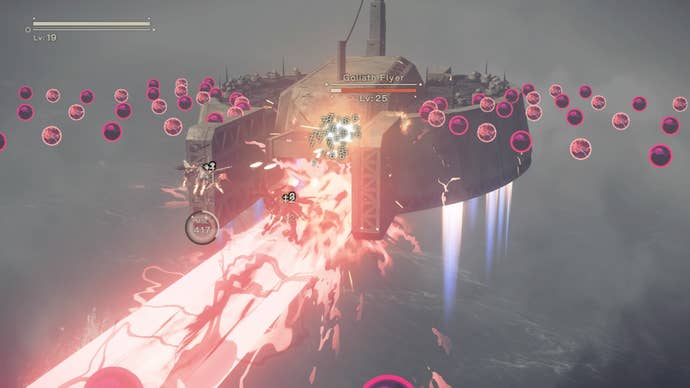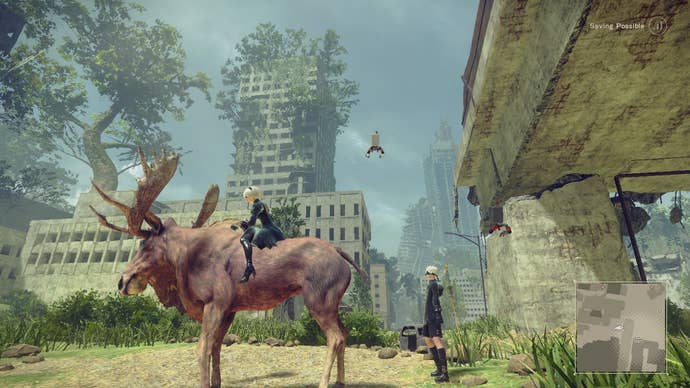Nier: Automata Review
Nier: Automata makes me feel so small, in the best of ways.
This article first appeared on USgamer, a partner publication of VG247. Some content, such as this article, has been migrated to VG247 for posterity after USgamer's closure - but it has not been edited or further vetted by the VG247 team.
Nier: Automata makes me feel so small. The first boss I encounter in its opening hours is a “goliath,” a catch-all term for “very big monster machine thing” that is slapped onto anything that makes you feel like an ant. This particular goliath towers higher than a skyscraper, and it resembles Big Shell from Metal Gear Solid 2. You battle the monstrous, location-sized being; first on foot, later hopping into your trusty, also pint-sized mecha. It’s an outrageous, contentious battle to the death that sets the tone for the rest of my initial playthrough: this game is badass, and it knows it.
The best bosses in games are the ones that make us feel impossibly strong in the face of adversity. Whether it's the leagues of colossi in Shadow of the Colossus, or any big baddie you face in a Final Fantasy game, bosses may make us feel small, but they also make us feel like we can do the impossible: destroy them, in spite of our size.
There’s a poetic semblance to the chaotic bosses of Nier: Automata. You always feel miniscule: whether your boss is Big Shell-sized, or akin to yourself. Every boss has their quirks; their challenges; their weaknesses—and no two battles require the same strategy. 2B, the silver-haired, absurdly short-skirted android you control at the start, is always kept on her toes: but she has her trusty swords and bullet-projecting pod to survive by. Sometimes in battles, in the non-boss variety as well, 2B lunges forward, slicing and dicing the perpetually-beige machines in her path. Sometimes a curtain of red orbs clouds her view, and the game evolves into something I can only describe as a bullet ballet: as entrancing bounds to avoid certain death become priority.
Nier: Automata combines bullethell chaos and the beauty of Platinum-specialized swordplay, and intertwines those with the occasional arcade-like 2D platformer-shooter. There’s no time for Nier: Automata to rest in the ideas it artfully marries and executes, and over the course of the campaign, it bends and twists its ideas to new strengths. Where every battle is a new test of coming to grips with dodging, having the ideal pod equipped (for myself, I bounced between a missile projecting pod and a more typical, incessantly firing one—which is handy when those deadly red orbs fly your way), and, of course, being agile and strategic like the android you are.

Nier: Automata is “open-world” in the emptiest sense of the definition. There’s a large hub for you to explore with varied areas (a desolate city, a forest, a desert, etc.)... and it’s open. There are some villages (though very few), a lot of robots in the wild to battle, and a scattershot of side missions. But unlike most open world games, its side missions aren't essential, or even baited as necessary. There’s no level spikes in the main story that urge you to seek them out to prove your worth and feel prepared in the strength sense. They solely exist if, hey, you just want more things to do (or want new gear). But Nier: Automata isn’t a game that revels in empty escort missions or monotonous combat against the same, tired enemies. It flourishes in its main quest line: whether you’re pulled along by its bizarre story and characters, or the incredible boss fights that couch every chapter.
Though, in spite of its open world blunders, style outweighs its actual graphical prowess. Its sometimes muddy textures and bland environments don't detract from what is visually compelling in the game: its fluid battles, its character design, and its more unique locales. Like when 2B leaps into action, her frenetic sword animates quicker than the eye can follow (even if the camera is a little stubborn at times). And whether you stroll through familiar post-apocalyptic sights—like buildings overtaken by grass—or slightly unfamiliar ones—like an abandoned theme park kept alive by machines—Nier: Automata is a game that leverages its world design above its technical shortcomings.
Leveling up in Nier: Automata is an easy task, whether you slog through side missions to make yourself overpowered, or just mainline the primary story. You grow stronger, in addition to slowly accumulating "Chips" of extra abilities (such as auto-healing or upping your chances of critical hits) that you can install into your pod. Chips are a mixture of defensive, offensive, and HUD elements; meaning you can even strip your screen bare of any indicators in favor of cramming in other abilities, if you so wish. It's a sort of skill tree that, at least aesthetically, fits perfectly into the game's android-centric, futuristic narrative. The menus and the game's abhorrent world map (seriously, it's virtually unnavigatable) even resemble a computer's interface, or at least, the YoRHa's version of what that its user interface would be.

The story that threads the game is outlandish, to put it mildly. At the start, you’re positioned as 2B, a YoRHa unit forever battling machines on Earth, long after humanity’s fled to the Moon for sanctuary. You’re accompanied by 9S, an overtly-friendly android, also with silver hair. The two androids form a bond over their long journey, despite 2B's anti-emotions conditioning as an android. And then things get wild.
Nier: Automata, like its cult classic predecessor (that unfortunately has always eluded me and I have never played), encourages multiple playthroughs. A second playthrough wields a new perspective and a stark gameplay change. A third is almost an entirely fresh experience for the player. It’s a game where if you only beat it once, you’ll feel wildly unfulfilled. There are dozens of faux-endings, some of the joke variety (like dying during the first boss), others of genuine mishaps. But at its core, it doesn’t tell its whole story with the first go-around, and only grows more interesting as it progresses.
I’m drawn back to the idea of feeling small; not in the open world way or the boss battle way, but small in a human sense. 2B and 9S may be androids, but the bond they eventually share is a quiet and personal one. Even when stuffed with every sci-fi oddity you can cram into a plot (Humans are on the moon! Some robots are nice for some unknown reason! There are rogue YoRHa units around!), at the end of the day, Nier: Automata dares to center its tale on something more sentimental: two androids wrestling with their small connection to humanity, and what that means for them.
But unfortunately, Nier: Automata couldn’t have come out at a worse time for me. With it arriving right before the Game Developer’s Conference last week (which I covered alongside Kat and Jaz), I wasn’t able to put sufficient time shortly before, during, or after the week-long conference. As such, I’ll be pouring a lot more time into the game this week through my multiple playthroughs (which I’m estimating is another 15 or so hours); working to see all the wild endings the game has to offer in order to give a proper review (score and all). But at the time of writing this, in spite of its flaws, I’m enjoying my time with the highly capable 2B and 9S. Stay tuned. Edit: You can find my final thoughts on Nier: Automata below!
Final Thoughts
When I wrote my impressions over the weekend, I was enjoying Nier: Automata. It was flawed around the edges—no doubt about that—but it was also refreshingly different and engaging. Here was a tale about two androids within a wonderfully imaginative backdrop, with wildly fun and efficient combat to spare and a dynamic score that swelled just as its emotional peaks did. Little did I know, by the end of my second playthrough, that the real game was only just beginning.

Nier: Automata is extremely brash. Your first two playthroughs give you two separate but often together characters to play as, seeing the same story unfold from different perspectives. There’s gameplay changes too, in addition to a few different scenarios and environments to uncover. But when I progressed through my third playthrough where the game’s final three endings culminate (which, though in the same open world, is entirely new content), I felt a rush of excitement. Everything I worked towards in my first playthroughs paled in comparison to this: a third act that felt like an incessant climax; like a sequel in and of itself, as if its first two playthroughs were just the prologue, mere child’s play.
It was this playthrough that cemented Nier: Automata for me. It’s a game that continuously subverts itself, from constantly reiterating how you play it (as it bounces from top-down shooter to swordplay at the blink of an eye), having a shopkeeper that sells you trophies (yes, trophies) to a mysterious NPC explaining to me just why those world maps were so damn bad (poor reception from satellites, it turns out, and androids like me just have to “deal with it”). Nier: Automata knows it’s a game, and it plays with that expectation in befitting ways.
Because of that, Nier: Automata is incredibly meta. It’s a game that challenges how we engage with games. We grind out trophies to get that platinum, or but in Nier: Automata, you can just buy your way to them. You can complain about badly designed world maps in games and bemoan their existence, or there can be a logical in-game reason to contextualize their poor quality. You can can play a game once and think you’ve seen it all, but really there’s about four more layers of plot and endings that you’re missing out on. Sure, I’m still a player. And Nier: Automata is still just a game. But in the end, as DJ Khaled might say, the game might just might end up playing you.
InterfaceKeeping in line with the android-centric narrative, Nier: Automata has a lot of unique little UI quirks. Your HUD can be minimized in the same space as your abilities, and the game's menu is aestheticized like an old computer's.
Lasting AppealWhile I don't see myself returning to Nier: Automata anytime soon, its narrative, world-building, astounding bosses, frenetic action, and cheeky sense of humor was more than enough to keep me engaged over my 40-hour playthrough to see its five main endings.
SoundKeiichi Okabe and Keigo Hoashi have composed an epic, beautiful (and even dynamic) score that still has me humming some of its tunes.
VisualsWhile not a graphical powerhouse by any means, the game's style rises above all else.
ConclusionWe don't get games like Nier: Automata too often. And by that I mean games that simultaneously weave a deeply harrowing existentialist narrative, in addition to playing with our expectations on how we play games. There's nothing else around like Nier: Automata (except for maybe its predecessor). And in an industry that sometimes leans too heavily on sameness, it's wholly refreshing.

